Lightning strikes increasing at a rate of 10% a year!
Lightning is the discharging or phenomenon which occurs to balance the difference of high voltage cells within clouds either between two clouds, to space, and yes the earth. The high voltage cells are created by friction created by the movement of the clouds creating potential or voltage between negative or positive charged cells or objects. Think of lightning as static electricity just on a much larger scale, the phenomenon simply is the act which temporarily neutralizes the positive and negative charges between objects.
Ten percent, an alarming statistic for such a powerful phenomenon. However there are things you can do to assist in the protection of your home and the items inside. Installing air terminals connected together and then to the earth utilizing large conductors gives your structure protection by affording a low impedance path to earth for the lightning strike. This method while providing protection for your structure does little for the protection of any appliances inside your home, it only helps to protect the structure from igniting due to the combustion involved with the neutralization of the voltage potential. To protect appliances inside the structure, surge protection must be installed.
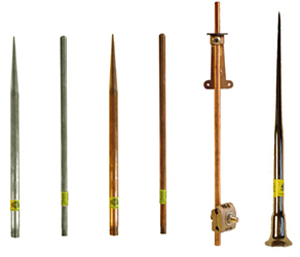
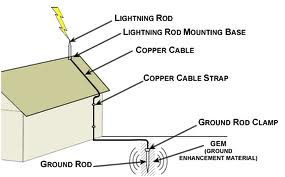
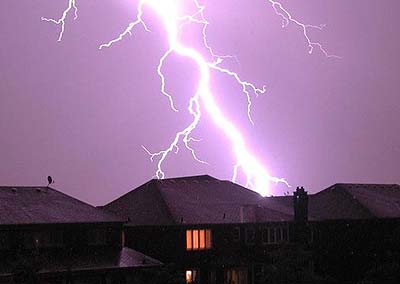
A typical 100 watt incandescent light bulb operates off of 120 volts, creating approximately .8 amps of current. Lightning bolts can have voltages as high as 30,000,000 volts at levels of over 20,000 amps. Over 100 deaths, 250 injuries, and billions of dollars in property damage each year can be contributed to lightning.

Lightning protection systems installations are only effective if total resistance between the air terminals and ground is maintained. Pictures of such systems are deceptive in that the routing of conductors between the air terminals and ground should be as near 0 degrees as possible, no bending of the conductors. All bends or connections of conductors increases the resistance. Additionally the ground connection resistance should be low which can only be confirmed by use of special ground resistive testers.
Air terminals used to provide a path for lightning strikes around structure.
Surge protection!
Surge protection is a means for protecting your electrical equipment from high voltage levels which can occur for many different reasons. Surge protection works with your existing grounding system to, in layman's terms, re-direct or allow a gateway for higher voltage levels to return back to the source. It will only be effective if there is a good path back to the source from any point of the electrical system where a surge event might occur. In most cases the source is the utility grid and the generator or source could be hundreds of miles away.
Surge devices for electrical system protection should be layered for effectiveness for all scenarios. Effective surge protection packages that include all of the following elements will be highly effective in protecting your electrical equipment:
- Single point grounding to the source and earth ground for all utilities, including electrical, phone, cable and or satellite services.
- Protection equipment that has high surge current ratings for durability so that a single surge event does not take out the protector itself.
- Protection equipment with low enough clamping voltage levels and quick response time.
- Effective connection to ground with resistance levels below 15 ohms.
- Surge protectors installed in layers.
- Surge protectors installed on all utilities, including electrical, phone, cable and or satellite services.
- Effective grounding connections between all components of the electrical system of the structure being protected.
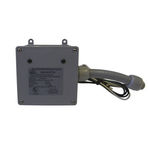
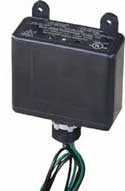
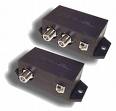


Using layers of devices and protecting all utility service including not only electrical but also cable, satellite, and phone interfaces is the only way to fully protect your structure's contents. All paths into a structure is necessary for full coverage.
Service and Panel device.
Satellite or cable device.
Phone line device.
Plug in receptacle device.
Appliance hard wired device.
A term used to define systems which provide a path for fault current or induced voltage surges , at levels high enough, that could cause considerable damage to persons or property. Correct grounding and attachment to ground, correct surge protection components, installed at multiple layers, in combination with single point grounding between all the different utility interfaces associated with structures, are all necessary for correctly designed protection systems. Meeting this criteria is really all you can do to protect yourself against surges created by whatever source. E&W provides for total power solutions including the design and installation of surge protection for Raleigh, Durham, Chapel Hill, and the Greensboro areas of North Carolina.
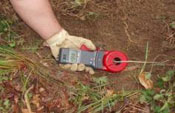
If connection to the utility electrical grid is lost, your structure's attachment to ground is critical.
Ground attachment and bonding.
All voltage, normal or surge events always try to get back to the source. Our electrical systems provide for this through a grounded conductor typically called, the neutral. This conductor is continuous between the source or generator which creates electricity and all electrical appliances. In combination to this continuous conductor back to the source, a paralleled ground attachment provides a low impedance path back to the source to facilitate the function of overcurrent devices that are used to clear fault currents which would be hazardous to persons or property if not cleared. A structures ground attachment should be a part of the grid's parallel ground attachment.
The grounding conductor should always be installed between all electrical system parts and their enclosures. This grounding conductor provides a path for fault current which is induced due to faults, (electrical shorts) between an electrical conductor and the non conductive or grounded appliance enclosure. Surges which exceed the insulation resistance of conductors would be dissipated to ground, either through the grounded phase conductor and its attachment to ground or through the system ground, depending on the size of the surge event. For a large surge event, the structures attachment to ground becomes pretty important.
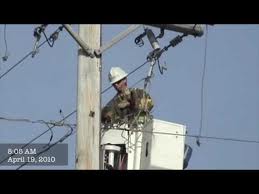
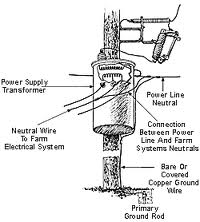
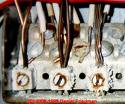

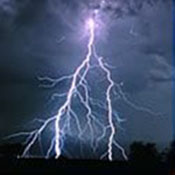
An occurrence of an auto taking out connections at a utility pole can create just as much damage as lightning if the ground connections are not kept intact.
All structures are connected to the utility grid neutral and parallel grid attachment. The bare or covered ground wire shown in the picture above is consistent at each power pole all the way back to the power generating plant or substation where voltage may be induced though high voltage transformers.
All individual, internal grounding connections must be maintained in order to afford the lowest possible resistance and guard against oxidation. Additionally, typically one ground rod is not sufficient in providing good attachment to earth.

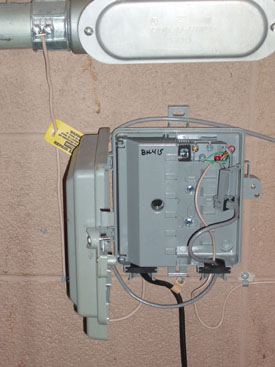

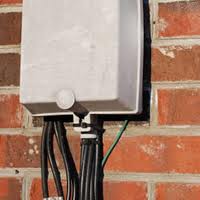
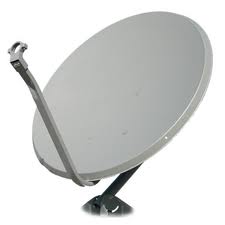
All utility interfaces have to be bonded together in order to make sure no potential for voltage can exist. This is a common problem which will make router failure a common occurrence. Without providing single point grounding nor installing surge protection equipment for these type utilities will limit your success with surge protection.
Surge Protection for Raleigh, Durham, Chapel Hill & Greensboro

E & W Electrical, LLC
515 Meadowland Drive
Suite 100
Hillsborough, NC 27278
919-245-0200 (office)
919-245-0202 (facsimile)
888-919-5210 (toll free)
copyright 2010 E & W Electrical ** All rights reserved

